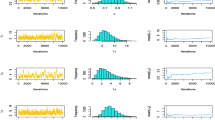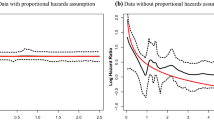Abstract
For many forms of cancer, patients will receive the initial regimen of treatments, then experience cancer progression and eventually die of the disease. Understanding the disease process in patients with cancer is essential in clinical, epidemiological and translational research. One challenge in analyzing such data is that death dependently censors cancer progression (e.g., recurrence), whereas progression does not censor death. We deal with the informative censoring by first selecting a suitable copula model through an exploratory diagnostic approach and then developing an inference procedure to simultaneously estimate the marginal survival function of cancer relapse and an association parameter in the copula model. We show that the proposed estimators possess consistency and weak convergence. We use simulation studies to evaluate the finite sample performance of the proposed method, and illustrate it through an application to data from a study of early stage breast cancer.




Similar content being viewed by others
References
Brewster AM, Do KA, Thompson PA, Hahn KM, Sahin AA, Cao Y, Stewart MM, Murray JL, Hortobagyi GN, Bondy ML (2007) Relationship between epidemiologic risk factors and breast cancer recurrence. J Clin Oncol 25:4438–4444
Chen MC, Bandeen-Roche K (2005) A diagnostic for association in bivariate survival models. Lifetime Data Anal 11:245–264
Chen YH (2012) Maximum likelihood analysis of semicompeting risks data with semiparametric regression models. Lifetime Data Anal 18:36–57
Clayton DG (1978) A model for association in bivariate life tables and its application in epidemiological studies of familial tendency in chronic disease incidence. Biometrika 65:141–151
Ding AA, Shi G, Wang W, Hsieh JJ (2009) Marginal regression analysis for semi-competing risks data under dependent censoring. Scand J Stat 36:481–500
Fine JP, Jiang H, Chappell RJ (2001) On semi-competing risks data. Biometrika 88:907–919
Fleming TR, Harrington DP (2005) Counting processes and survival analysis. Wiley, Chichester
Frank M (1979) On the simultaneous associativity of f(x, y) and x + y - f(x, y). Aequ Math 19:194–226
Gill RD (1980) Censoring and stochastic integrals. Mathematisch Centrum, Amsterdam
Gumbel EJ (1960) Bivariate exponential distributions. J Am Stat Assoc 55:698–707
Hsieh JJ, Wang W, Ding AA (2008) Regression analysis based on semicompeting risks data. J R Stat Soc Series B Stat Methodol 70:3–20
Hsieh JJ, Huang YT (2012) Regression analysis based on conditional likelihood approach under semi-competing risks data. Lifetime Data Anal 103:302–320
Jiang H, Fine JP, Kosorok MR, Chappell RJ (2005) Pseudo self-consistent estimation of a copula model with informative censoring. Scand J Stat 32:1–20
Kaplan EL, Meier P (1958) Nonparametric estimation from incomplete observations. J Am Stat Assoc 53:457–481
Oakes D (1982) A model for association in bivariate survival data. J R Stat Soc B 44:414–422
Oakes D (1989) Bivariate survival models induced by frailties. J Am Stat Assoc 84:487–493
Peng L, Fine JP (2007) Regression modeling of semicompeting risks data. Biometrics 63:96–108
Peng L, Jiang H, Chappell RJ, Fine JP (2007) Statistical advances in the biomedical sciences: clinical trials, epidemiology, survival analysis, and bioinformatics. Wiley, Hoboken
Shih JH, Louis TA (1995) Inferences on the association parameters in copula models for bivariate survival data. Biometrics 51:1384–1399
Siegel R, Ma J, Zou Z, Jemal A (2014) Cancer statistics, 2014. CA Cancer J Clin 64:9–29
Wang W (2003) Estimating the association parameter for copula models under dependent censoring. J R Stat Soc Series B Stat Methodol 65:257–273
Xu J, Kalbfeisch JD, Tai B (2010) Statistical analysis of illness-death processes and semicompeting risks data. Biometrics 66:716–725
Acknowledgments
The authors thank the editor, the associate editor and two reviewers for their constructive comments that have greatly improved the initial version of this paper. This work was supported in part by Cancer Center Support Grants from the National Institutes of Health (CA142543 to Hong Zhu at UT Southwestern Medical Center and CA016672 to Jing Ning at UT MD Anderson Cancer Center) and by a predoctoral fellowship grant from the Cancer Prevention Research Institute of Texas (RP140103 to Renke Zhou).
Author information
Authors and Affiliations
Corresponding author
Additional information
Renke Zhou and Hong Zhu have contributed equally to this work.
Appendix
Appendix
Proof of Theorem 2
Asymptotic results of \(\hat{S}_1(t)\) are proved under the following regularity condition. Function \(g(u, v, \alpha )\) is continuous and differentiable at u, v, and \(\alpha \), respectively, and the parameter \(\alpha \) lies in a compact set.
First, we show the consistency of \(\hat{S}_1(t)\). We have that \(\hat{S}_2(t)\) converges in probability to \(S_2(t)\) uniformly for \(t\in [0,\tau ]\), and \(\hat{S}_Z(t)\) converges in probability to \(S_Z(t)\) uniformly for \(t\in [0,\tau ]\). By Theorem 1, \(\hat{\alpha }\) converges in probability to \(\alpha _0\). Since the function \(g(u, v, \alpha )\) is a continuous function of u, v and \(\alpha \), \(g\{\hat{S}_2(t), \hat{S}_{Z}(t), \hat{\alpha }\}\) converges in probability to \(g\{S_2(t), S_{Z}(t), \alpha _0\}\) uniformly for \(t\in [0,\tau ]\). Therefore, \(\hat{S}_1(t)\) is a consistent estimator of \(S_1(t)\).
Next, we illustrate the asymptotic distribution of \(\hat{S}_1(t)\). Applying the functional delta method to \(g\{\hat{S}_2(t), \hat{S}_{Z}(t), \hat{\alpha }\}\) around \(S_2(t)\), \(S_Z(t)\) and \(\alpha _0\), we have
Using martingale representations for \(\hat{S}_2\) and \(\hat{S}_Z\) (Gill 1980), the sum of the first and second terms in (8) is asymptotically equivalent to
which is a sum of n independent and identically distributed random variables, with \(I_1^0(Y_{i},\delta _{2i})\) and \(I_2^0(Z_{i},\delta _{zi})\) defined as in the previous section. Also the expectation of each term in (9) is zero. By the central limit theorem, (9) converges weakly to a normal distribution with mean zero and variance \(\omega ^2(t)\). By Theorem 1, \(n^{1/2}(\hat{\alpha }-\alpha _0)\) converges weakly to a normal distribution with mean zero and variance \(\rho ^2\). Therefore, the third term in (8) is asymptotically equivalent to
which is a sum of n independent and identically distributed random variables.
Moreover, we have
which means that (9) and (10) are asymptotically orthogonal. Therefore, (9), (10) and (11) imply that as \(n\rightarrow \infty \), the process \(n^{1/2}\{\hat{S}_1(t)-S_1(t)\}\) converges weakly to a zero-mean Gaussian process for \(t\in [0,\tau ]\) with covariance function \(\Big [\frac{\partial g\{S_2(t), S_{Z}(t), \alpha \}}{\partial \alpha }\Big ]^2\rho ^2+\omega ^2(t)\). \(\square \)
Rights and permissions
About this article
Cite this article
Zhou, R., Zhu, H., Bondy, M. et al. Semiparametric model for semi-competing risks data with application to breast cancer study. Lifetime Data Anal 22, 456–471 (2016). https://doi.org/10.1007/s10985-015-9344-x
Received:
Accepted:
Published:
Issue Date:
DOI: https://doi.org/10.1007/s10985-015-9344-x




